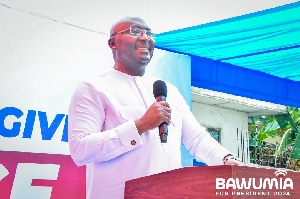- Home - News
- TWI News | TV
- Polls
- Year In Review
- News Archive
- Crime & Punishment
- Politics
- Regional
- Editorial
- Health
- Ghanaians Abroad
- Tabloid
- Africa
- Religion
- Election 2020
- Coronavirus
- News Videos | TV
- Photo Archives
- News Headlines
- Press Release
Opinions of Wednesday, 29 April 2020
Columnist: Iddrisu Bariham
Education in crisis: Impact of migration and displacement on education
Migration and displacement are two critical global challenges that pose significant threats to the realization of the 17 SDGs by many countries.
Migration can be internal or international and often motivated by several factors including employment, education, climate change, conflicts
among others.
Data from Global Education Monitoring Report (2019) indicated that almost 1 in 8 people are internal migrants; residing in regions, they were not previously born. About 1 in 30 are international migrants, and two-third of them live in the developed world.
From global perspective, the total number of international migrants ballooned from 93 million in 1950 to 258 million in 2017. In OECD countries, the percentage of the first and second-generation immigrant students increased from 9.4% to 12.5% between 2006 and 2015.
Education raises the propensity to migrate. The more educated are likely to migrate than the less educated.
Global migration data showed that 5.4% for people with tertiary education, 1.8% for those with secondary education, and 1.1% for people with primary education are likely to migrate (Global
Education Monitoring Report, 2019). Rate of immigration varied across countries and are three times higher than the global average in countries such as South Africa, Malaysia, Cote d’Ivoire and Costa Rica (International Organization for Migration, 2017).
In Ghana, wage differentials between rural and urban areas, chronic poverty, conflicts, and outmoded cultural practices push people to migrate from the north to the southern part of the country. In some instances, girls drop
out of school to migrate to the cities in the south where they serve as head porters.
This limit their future life opportunities. The trend needs to be addressed if we are to achieve the SDG goal 4, which focuses on inclusive quality education for all by 2030,
Impact of Migration on Education
The literature on the impact of migration on education has generated mixed conclusions.
However, the majority of the studies established a strong correlation between migration and education. Education plays a key role of whether to migrate or not. Migration and displacement can significantly affect education, calling for new strategies and innovations to house those who move and those left behind.
Rural migrants moving to the cities for education can improve their
level of education enabling them to acquire relevant employable knowledge, skills, and competencies. However, the majority of internal migrants especially the youth in developing countries including Ghana usually stay in slums, which lack access to basic necessities of life including education.
Presently, 1 billion people live in slums, poorly developed and overcrowded
settlements (UN-Habitat, 2020). In Bangladesh and Dhaka for instance, as little as one-quarter of slums were equipped with public schools (Global
Education Monitoring Report, 2019). This implies limited access to inclusive and quality education and lifelong learning for children in
those communities.
Migration enhances education outcomes for some people but not all. Migration whether local or international affect the education of the children left behind, but that also depend on the setting.
Remittances from parents may help in meeting the cost of education of the children. However, where parents are not able to send remittances, children may have not option than to drop out of school. For example, Mexican girls completed more years of school if father migrated to the USA, but not if they migrated within Mexico (Antman, 2012).
Sometimes children themselves migrate, in most cases not accompanied. The number of unaccompanied minors ballooned globally from 66,000 in 2010-2011 to about 300,000 in 2015-2016 (UNICEF, 2017). These unaccompanied and undocumented international children migrants
become vulnerable and may be denied access to quality education and lifelong learning opportunities. Some of these children may even end up in detention centers.
In most cases, children with disabilities are often ignored. Migrant or refugee children with disabilities faces
multiple barriers to education.
The recent COVID 19 has and is causing significant social transformation across the world including education. The need for Social Distancing led to the closure of schools worldwide. The shutdown of schools has resulted in the use of virtual learning to deliver instructions to students.
Migrants children from slums and those in the rural communities are already disadvantaged and are 6 times likely not to have access to computers, laptops, and internet to be able to effectively participate in those online learning.
The result is that a significant portion of children will be left
behind.
Stateless people face discrimination and could be denied access to education. Recent data extrapolated that over 10 million people across the globe are stateless and do not have any recognized nationality. These stateless people face barriers to quality education in several ways including discrimination.
In Cote d’Ivoire for instance, access to primary education is dependent
on the child’s ability to prove nationality (UNHCR, 2015).
In Ghana, the incidence of poverty is higher in the five Northern Regions. As a result, most of the youth often migrate to the cities (especially Accra, and Kumasi) in the south to search for non-existing jobs. The majority of these youth are often girls who drop out of school to fend for
themselves. The very weak social protection system coupled with a high rate of youth unemployment often perpetuates the practice.
The recent lockdowns of Accra and Kumasi occasioned by the COVID 19 pandemic led the displacement of some of these female porters in those cities. Data on the exact number of youth migrants in Ghana is difficult to obtain but the fact remains that due to poverty, some children are leaving school to migrate to the cities to work. These must end if we are to meet the SDGs by 2030.
The way forward
Education is fundamental human rights and hence, governments should respect the right to education of all including migrants and displaced people. Respecting the right to education should go beyond legislation and bureaucratic administrative systems to strategies that are more
practical on the ground aimed at addressing the issue. Governments should involve displaced people and migrants in the national educational policy planning and implementation process.
Migrants and displaced people should benefit from national education without any discrimination. Governments should tap into the knowledge, skills, and other potentials of migrants and apply them for the good of society. More schools should be established to provide education to migrants, and displaced people in crisis settings. Teachers should be trained on how to deliver inclusive quality instruction to refugees, migrants and displaced people in crisis contexts.
Governments should collaborate on how to deliver inclusive quality education and lifelong learning opportunities for all.











